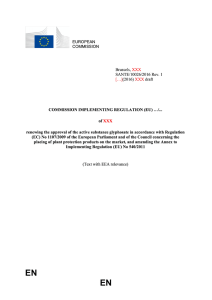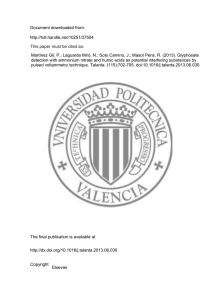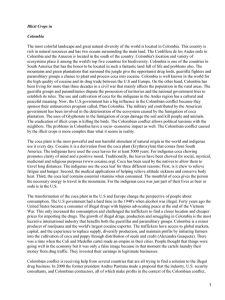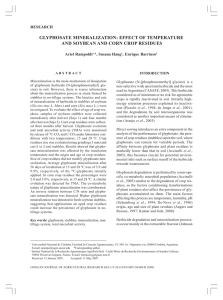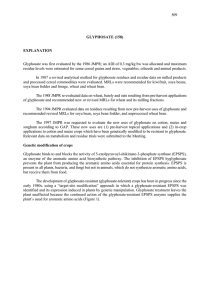Coca (Erythroxylum coca) Control is Affected by Glyphosate
Anuncio
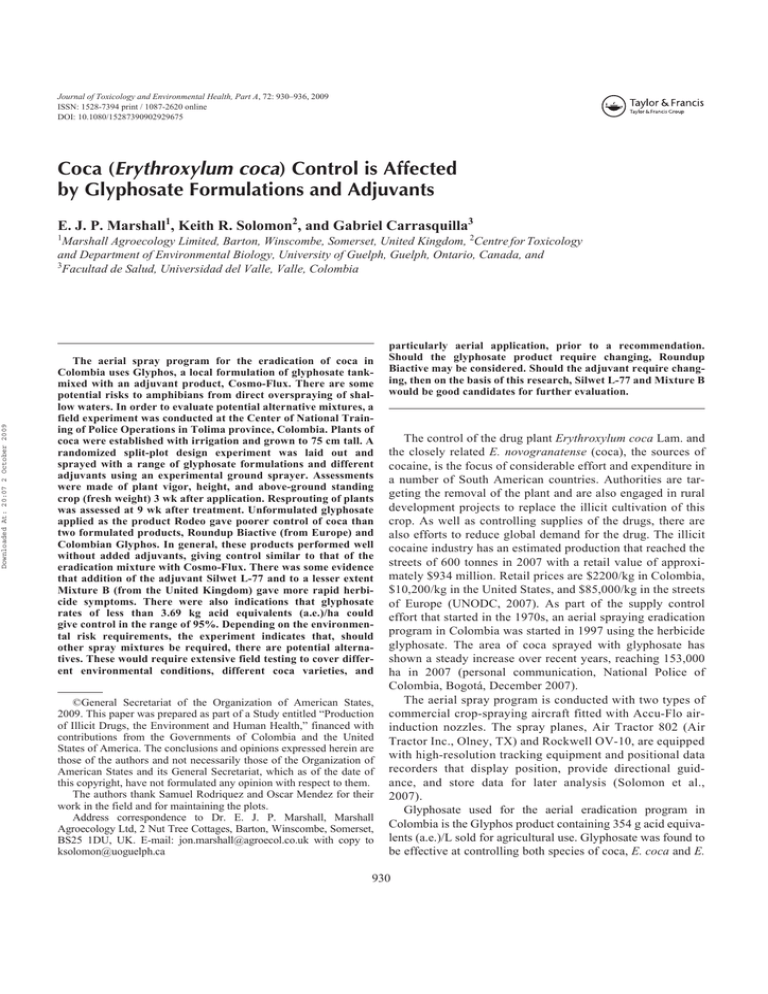
Journal of Toxicology and Environmental Health, Part A, 72: 930–936, 2009 ISSN: 1528-7394 print / 1087-2620 online DOI: 10.1080/15287390902929675 Coca (Erythroxylum coca) Control is Affected by Glyphosate Formulations and Adjuvants UTEH E. J. P. Marshall1, Keith R. Solomon2, and Gabriel Carrasquilla3 Coca Control is Affected by Glyphosates 1 Downloaded At: 20:07 2 October 2009 Marshall Agroecology Limited, Barton, Winscombe, Somerset, United Kingdom, 2Centre for Toxicology and Department of Environmental Biology, University of Guelph, Guelph, Ontario, Canada, and 3 Facultad de Salud, Universidad del Valle, Valle, Colombia The aerial spray program for the eradication of coca in Colombia uses Glyphos, a local formulation of glyphosate tankmixed with an adjuvant product, Cosmo-Flux. There are some potential risks to amphibians from direct overspraying of shallow waters. In order to evaluate potential alternative mixtures, a field experiment was conducted at the Center of National Training of Police Operations in Tolima province, Colombia. Plants of coca were established with irrigation and grown to 75 cm tall. A randomized split-plot design experiment was laid out and sprayed with a range of glyphosate formulations and different adjuvants using an experimental ground sprayer. Assessments were made of plant vigor, height, and above-ground standing crop (fresh weight) 3 wk after application. Resprouting of plants was assessed at 9 wk after treatment. Unformulated glyphosate applied as the product Rodeo gave poorer control of coca than two formulated products, Roundup Biactive (from Europe) and Colombian Glyphos. In general, these products performed well without added adjuvants, giving control similar to that of the eradication mixture with Cosmo-Flux. There was some evidence that addition of the adjuvant Silwet L-77 and to a lesser extent Mixture B (from the United Kingdom) gave more rapid herbicide symptoms. There were also indications that glyphosate rates of less than 3.69 kg acid equivalents (a.e.)/ha could give control in the range of 95%. Depending on the environmental risk requirements, the experiment indicates that, should other spray mixtures be required, there are potential alternatives. These would require extensive field testing to cover different environmental conditions, different coca varieties, and ©General Secretariat of the Organization of American States, 2009. This paper was prepared as part of a Study entitled “Production of Illicit Drugs, the Environment and Human Health,” financed with contributions from the Governments of Colombia and the United States of America. The conclusions and opinions expressed herein are those of the authors and not necessarily those of the Organization of American States and its General Secretariat, which as of the date of this copyright, have not formulated any opinion with respect to them. The authors thank Samuel Rodriquez and Oscar Mendez for their work in the field and for maintaining the plots. Address correspondence to Dr. E. J. P. Marshall, Marshall Agroecology Ltd, 2 Nut Tree Cottages, Barton, Winscombe, Somerset, BS25 1DU, UK. E-mail: [email protected] with copy to [email protected] particularly aerial application, prior to a recommendation. Should the glyphosate product require changing, Roundup Biactive may be considered. Should the adjuvant require changing, then on the basis of this research, Silwet L-77 and Mixture B would be good candidates for further evaluation. The control of the drug plant Erythroxylum coca Lam. and the closely related E. novogranatense (coca), the sources of cocaine, is the focus of considerable effort and expenditure in a number of South American countries. Authorities are targeting the removal of the plant and are also engaged in rural development projects to replace the illicit cultivation of this crop. As well as controlling supplies of the drugs, there are also efforts to reduce global demand for the drug. The illicit cocaine industry has an estimated production that reached the streets of 600 tonnes in 2007 with a retail value of approximately $934 million. Retail prices are $2200/kg in Colombia, $10,200/kg in the United States, and $85,000/kg in the streets of Europe (UNODC, 2007). As part of the supply control effort that started in the 1970s, an aerial spraying eradication program in Colombia was started in 1997 using the herbicide glyphosate. The area of coca sprayed with glyphosate has shown a steady increase over recent years, reaching 153,000 ha in 2007 (personal communication, National Police of Colombia, Bogotá, December 2007). The aerial spray program is conducted with two types of commercial crop-spraying aircraft fitted with Accu-Flo airinduction nozzles. The spray planes, Air Tractor 802 (Air Tractor Inc., Olney, TX) and Rockwell OV-10, are equipped with high-resolution tracking equipment and positional data recorders that display position, provide directional guidance, and store data for later analysis (Solomon et al., 2007). Glyphosate used for the aerial eradication program in Colombia is the Glyphos product containing 354 g acid equivalents (a.e.)/L sold for agricultural use. Glyphosate was found to be effective at controlling both species of coca, E. coca and E. 930 Downloaded At: 20:07 2 October 2009 COCA CONTROL IS AFFECTED BY GLYPHOSATES novogranatense (Ferreira et al., 1997). The aerial application rate of glyphosate is 3.69 kg a.e./ha in Colombia. To maximize penetration and effectiveness of the spray formulation, glyphosate is tank-mixed with an adjuvant product (CosmoFlux 411F; Cosmoagro, Bogotá). The inclusion of the adjuvant follows the studies of Collins and Helling (2002), who demonstrated a fourfold increase in glyphosate efficacy by including suitable adjuvant mixtures in the spray. Surfactants, such as the polyethoxylates in Cosmo-Flux, enhance efficacy through (1) increasing target surface adherence, (2) promoting better droplet spread, (3) better dispersion, (4) prevention of aggregation, and (5) enhanced penetration of herbicides into target plant tissues through the reduction of surface tension on plants. Surfactants also disrupt the water-insoluble wax cuticle, thus increasing the penetration of herbicide active ingredient. Base oils, such as the isoparaffins in Cosmo-Flux, are another class of adjuvants used in pesticide formulations to primarily aid foliar absorption of the pesticide by disrupting the waxy cuticle on the outer surface of foliage, which increases permeability (Solomon et al., 2007). Environmental risk assessments of the aerial eradication program indicated that the relative impact of the glyphosate mixture is small in comparison with the impacts of forest clearance for cropping (Solomon et al., 2007). Nevertheless, there could be some impact on amphibian species in shallow waters (<30 cm deep) that are directly oversprayed. Such effects are unlikely to be due to glyphosate, but to the adjuvants present in the spray mixture. Further ecotoxicological tests were conducted with the spray mix as used in Colombia (Bernal et al., 2009a, 2009b). Developments in adjuvant research indicate that it may be possible to identify an adjuvant mixture or mixtures as effective as the current mixture, but with less risk to native amphibians. The field experiment described here was conducted as an initial step to evaluate the efficacy of a range of glyphosate formulations mixed with different adjuvants. It was postulated that alternative combinations might give as good or better control of coca than the formulation currently used in the aerial eradication program. As noted earlier, reduced toxicity of the spray mixture may have environmental benefits, plus there is potential for reducing the application rate of glyphosate when mixed with different adjuvants used in the aerial eradication program. With approximately 153,000 ha sprayed in Colombia in 2007, there would be considerable cost savings if a reduced rate gave as good control as current practice. MATERIALS AND METHODS Site The field site was located on a finca (ranch) in County San Luis in the Department of Tolima, Colombia. The area is to the west of Bogotá between the eastern and central mountain 931 ranges of the Andes, located at N 04º 15.971, W 75º 01.373, and at 517 m above sea level (a.s.l.). The soils are valley alluvia. The selected area was initially covered with grasses, sedges, and low shrubs. This was mown with a tractor-mounted bush cutter, then sprayed with glyphosate and ploughed. The site was cultivated and the plants were hand planted in rows 1 m apart on 1-m spacings in plots of 60 plants, with each plot arranged with 6 rows of 10 plants. The planting and agronomy of the plants match much of the pattern of illicit growing, where pesticides (permethrin and mancozeb) and fertilizer are used to promote crop production. Irrigation was applied approximately twice per week, to enhance survival and growth. Plant Material Cuttings of E. coca variety Pajarito were obtained from the Department of Cauca, in the southwest of Colombia. Cuttings were initially maintained in a shade house in December 2006, treated as necessary with fertilizer, fungicide, and insecticide and then planted out on 15 January and 20 January 2007. Plants that did not survive were replaced. Plants were allowed to grow to approximately 75 cm tall. Two weeks prior to spray treatment, taller plants were trimmed to 75 cm. Design Layout and Treatments There were 49 plots of 60 plants, of which 36 were selected for experimental use on the basis of good shrub growth. These plots, each representing a main plot, were grouped into three blocks across the experimental area. Main plots (60 plants) were allocated to 1 of 12 glyphosate/adjuvant treatments at random. Three glyphosate formulations were used: Colombian Glyphos (354 g a.e./L, Monsanto), Roundup Biactive (360 g a.e./L, Monsanto Europe), and Rodeo® (479 g a.e./L, Dow AgroSciences). Glyphos is formulated with adjuvants based on polyethoxylated tallowamines (POEA) for agricultural use. Roundup Biactive, a European product, uses a patented blend of surfactants less dependent on tallowamines for use in or near water. Rodeo is an unformulated glyphosate product, lacking adjuvants. Five adjuvants were also used: Cosmo-Flux, Intake, Mixture B, Silwet L-77, and LI-700. Cosmo-Flux is an agricultural adjuvant containing nonionic surfactants (a mixture of linear and aryl polyethoxylates: 17% w/v) and isoparaffins (83% v/v) (Cosmoagro 2004). Intake (Headland Agrochemicals Ltd., Great Chesterford, United Kingdom) is an agricultural penetrant containing 40% (w/w) propionic acid. Mixture B (AmegA Sciences, Daventry, United Kingdom) is 50% (w/v) nonylphenol ethylene oxide condensate and 50% (w/v) primary alcohol ethylene oxide condensate. Silwet L-77 (GE Silicones, Wilton, CT) is 99.5% (w/w) polyalkyleneoxide modified heptamethyltrisiloxane, a nonionic organosilicone. LI-700 (Nufarm Agriculture, Inc., Calgary, Canada) is a penetrant and acidifier composed of phosphatidylcholine, methylacetic acid, and alkyl polyoxyethylene ether. 932 E. J. P. MARSHALL ET AL. Downloaded At: 20:07 2 October 2009 A split-plot design was created by dividing each main plot into three subplots, each of two adjacent rows of coca bushes (20 plants). Subplots were randomly ascribed to receive one of three rates of glyphosate (all rates as a.e.): 1 kg/ha, 2 kg/ha, and 4 kg/ha. Aerial application rates of glyphosate are 3.69 kg/ha in Colombia, but 2 lower rates were selected for field testing, in order to evaluate efficacy and survival at lower application rates. Herbicide and adjuvant treatments were applied with a three-nozzle plot sprayer, mounted with 8002 Teejet nozzles (Spraying Systems Co., Wheaton, IL) 50 cm above the canopy. Calibrations showed the sprayer delivered a volume rate of 200 L/ha at 3 bar (40 psi) boom pressure at the calibrated forward speed. These treatments were ground applied, so necessarily the volume applied was higher than that used in the aerial application. This facilitated accurate small plot studies of a manageable size. Windshields were placed between subplots to prevent any drift between treatments. Applications were made on 1 and 2 August 2007 with air temperatures increasing during the day from 25 to 33ºC and relative humidities declining from 80% to 40% at midday. Assessments Prior to treatment, the maximum height and two widths (maximum and at 90º; Diameter-A, Diameter-B) of each coca bush were measured, allowing the calculation of bush area based on an ellipse: Ellipse area = Π (Diameter-A / 2)(Diameter-B / 2) (1) and bush volume: Bush volume = ellipse area × height (2) Heights, ellipse area, and volume could be used as covariates in univariate analyses. Plant symptoms were scored on a 5-point scale (Table 1) for individual bushes 1 wk (8 August 2007) and 3 wk after spraying TABLE 1 Symptom Scores for Coca Plant Health Score Effect 1 2 None Slight 3 Moderate 4 Strong 5 Killed Symptoms Leaves green, healthy A few leaves yellowing, brown edges; healthy new growth Half the leaves yellow or brown; some recovery Most leaves yellow, brown or fallen; no recovery All leaves brown or fallen (21 August 2007). At the same time, maximum bush heights were recorded. All bushes were harvested at ground level 3 wk after treatment (22 August 2007) and total fresh weight for each subplot was determined. Six weeks after harvesting (9 wk after spraying) on 5 October 2007, numbers of sprouts per stem were counted to measure plant recovery. These data were used to give a survival rate out of 20 plants per subplot. Statistical Analysis Data were analyzed using analysis of variance (ANOVA) of a split-plot design. Data were transformed as necessary to comply with the need for normality, following examination of residuals; square root or log.10 transformations (n +0.05) were used. Plant heights were analyzed using initial bush heights as a covariate. Vigor scores were analyzed using bush ellipse area as a covariate, reflecting potential herbicide coverage and therefore dose per bush. The Genstat 9th edition package (VSN International, Hemel Hempstead, UK) was used for analyses and data transformations. There were two spraying errors, so the four affected subplots were treated as missing values in the analyses. RESULTS Plant Height and Bush Size Analysis of the initial bush heights prior to treatment (mean height 80 cm) indicated there were some significant differences between treatments. Analysis of the ellipse area of each bush also indicated some initial and systematic differences across the experiment, despite arranging the plots into blocks. Plots to receive treatments 4 and 8 (Glyphosate + Intake; Roundup Biactive + Silwet L-77) had the smallest bushes, while plots with treatments 6 and 11 (Glyphosate + Silwet L-77; Rodeo + Silwet L-77) had the largest plants. These results confirmed that it was necessary to use covariates representing plant size at treatment in statistical analyses. Three weeks after treatment, on 21 August 2007, plant heights were measured. Analysis using bush volume as a covariate indicated that treatments and application rate were significant factors, but there was no interaction. Higher rates of glyphosate gave shorter plants. Plant heights were not significantly shorter than untreated controls on plots that had been treated with Glyphos + Silwet L-77 and Rodeo + LI-700 (Figure 1). The shortest plants were found on plots treated with Glyphos + Intake, Roundup Biactive alone, and Roundup Biactive + Silwet L-77. Symptom Scores One week after treatment, symptoms of glyphosate were developing on treated plants. There were significant differences 933 COCA CONTROL IS AFFECTED BY GLYPHOSATES 82 Plant height (cm) 80 LSD = 2.145 78 76 74 72 70 + G ly ph os G U ns pr ay ed co nt ro ly l ph os on C l y os m G oly Fl ph ux os G ly + ph In os ta ke G + ly M ph ix os tu re + B Si R ou lw R et nd o Lun up 77 du Bi p ac Bi tiv R a e ou ct + iv nd e Si R up lw ou et Bi nd a L up ct -7 iv 7 Bi e ac + LI tiv -7 e 00 + R M od ix eo tu r e + B Si lw et R L od -7 eo 7 + LI -7 00 68 treatment and rate effects and an interaction. All treatments showed glyphosate effects (Table 3) compared with the controls. At the lowest rate of glyphosate, the highest symptom scores and therefore the most activity were shown with Glyphos + Intake and Roundup Biactive with Silwet L-77 and Mixture B. At 2 kg /ha, the greatest activity was shown by Glyphos alone, Roundup Biactive alone, Glyphos with Silwet L-77 or Mixture B, and Roundup Biactive with Mixture B. At the highest rate of 4 kg /ha, the poorest treatment was Rodeo + LI-700. When comparing the glyphosate formulations, Rodeo gave lower vigor scores than Glyphos or Roundup Biactive across the adjuvant treatments, indicating less overall activity. There was a trend for Roundup Biactive to give higher scores at the lowest rate, in comparison with the other formulations. Downloaded At: 20:07 2 October 2009 FIG. 1. Mean coca plant height (cm) on plots treated with different glyphosate formulations and adjuvants 3 wk previously. (SED = 1.094; df = 2041). between treatments and rates of glyphosate (Table 2). All treatments, apart from the low rate of Roundup Biactive + LI-700 were significantly different from the controls and higher scores were found at the higher rates of the herbicide. At the lowest rate of glyphosate (1 kg/ha), the treatments with the products Glyphos and Roundup Biactive with Silwet L-77 had higher scores than other adjuvants. The treatment with Roundup Biactive + Mixture B also showed good activity. At 2 kg/ha, Glyphos with Silwet L-77 and Glyphos alone had highest activity, with Roundup Biactive alone or with Mixture B also showing good activity. Three weeks after treatment, on 21 August 2007, glyphosate symptoms were well developed, with plants clearly dying and leaves dropping. Statistical analyses again showed significant Fresh Weights The fresh weights of coca were not significantly different to controls on only 6 treatments (coefficient of variation = 21%), all at the 1-kg/ha rate of glyphosate. These treatments were Glyphos alone, Glyphos with Cosmo-Flux, Mixture B, or Silwet L-77, and the two mixtures of LI-700 with Roundup Biactive and Rodeo. At 2 kg/ha, the lowest standing crop was found on plots treated with Glyphos and Silwet L-77 or Mixture B (1.62 kg). Interestingly, the only 2-kg/ha treatments that were statistically greater than this were the two other Silwet L-77 treatments and the control. At 4 kg /ha, lowest standing crop was found with the Glyphos + Cosmo-Flux treatment, but none of the plots were statistically different from each other. Only Rodeo + LI-700 plots had fresh weights statistically different from the Glyphos + Cosmo-Flux at this rate. TABLE 2 Symptom Scores (0–5) for Coca Plants 1 wk after Treatment with Different Glyphosate Formulations and Adjuvants and Three Rates of Glyphosate (SED = 0.11; df = 2041) Adjuvant Name Concentration (%v/v) 1 kg/ha 2 kg/ha 4 kg/ha Water control – Cosmo-Flux Intake Mixture B Silwet L-77 – Silwet L-77 LI-700 Mixture B Silwet L-77 LI-700 – – 2.3 0.5 2 1 – 1 0.5 2 1 1 2.2 2.6 2.7 2.8 2.5 3.2 2.7 3.0 2.3 3.1 2.9 2.5 2.2 3.2 3.0 2.7 3.0 3.3 3.1 2.9 2.9 3.1 3.0 2.6 2.0 3.3 3.7 3.2 3.2 3.5 2.8 3.3 3.2 3.3 3.1 2.6 Glyphosate product None Glyphos Glyphos Glyphos Glyphos Glyphos Roundup Biactive Roundup Biactive Roundup Biactive Roundup Biactive Rodeo Rodeo Glyphosate rate Overall LSD (p = .05) = 0.21. 934 E. J. P. MARSHALL ET AL. TABLE 3 Symptom Scores (0–5) for Coca Plants 3 wk after Treatment with Different Glyphosate Formulations and Adjuvants and Three Rates of Glyphosate (SED = 0.12; df = 2041) Adjuvant Name Concentration (%v/v) 1 kg/ha 2 kg/ha 4 kg/ha Water control – Cosmo-Flux Intake Mixture B Silwet L-77 – Silwet L-77 LI-700 Mixture B Silwet L-77 LI-700 – – 2.3 0.5 2 1 – 1 0.5 2 1 1 2.2 2.5 2.5 3.2 2.7 3.1 3.1 3.3 2.7 3.2 2.8 2.7 2.4 4.1 3.5 3.3 3.7 3.8 3.8 3.4 3.3 3.7 3.2 3.1 2.2 4.2 4.4 4.3 4.5 4.5 4.1 4.4 4.0 4.3 3.9 3.4 Glyphosate product None Glyphos Glyphos Glyphos Glyphos Glyphos Roundup Biactive Roundup Biactive Roundup Biactive Roundup Biactive Rodeo Rodeo Glyphosate rate DISCUSSION In terms of treatment efficacy, there are a number of factors to consider. Outright plant kill, interpreted from the survival % survival 80 70 60 LSD = 22.8 50 1.0 kg/ha 2.0 kg/ha 4.0 kg/ha 40 30 20 10 co nt G G ro ly ly l ph ph os os on + C ly os m G oly Fl ph ux os G ly + ph In os ta ke G + ly M ph ix os tu re + B Si R ou lw R e nd ou tL up nd -7 Bi 7 up ac Bi tiv R a e ct ou + iv nd e Si R up lw ou et Bi nd a L up ct -7 iv 7 Bi e ac + LI tiv -7 e 00 + R M od ix eo tu r + e B Si lw et R Lod 7 7 eo + LI -7 00 0 ns pr ay ed Recovery After all coca bushes had been cut, the plots were left to recover, with occasional watering. On 5 October 2007, the numbers of sprouts per bush showed that most glyphosate treatments gave good control, but these data (not shown) were rather variable (coefficient of variation >50%). Only the low rate of Glyphos + Mixture B was similar to untreated control plots. The Rodeo formulation was less active than other formulations tested. There were indications that at the 2- and 4-kg/ha rates of glyphosate, the Glyphos formulation was as efficacious alone, compared with mixtures with adjuvants. At 2 kg/ha, the best mixtures were Glyphos and Roundup Biactive with the adjuvants Silwet L-77 and Mixture B. In terms of the numbers of surviving plants 9 wk after treatment, only half of the control plants were actively growing (Figure 2). In terms of survival, glyphosate activity was poor in the Rodeo formulation, relative to other treatments. The Glyphos formulation worked well at the 2- and 4-kg/ha rates. Roundup Biactive gave slightly higher survival overall, but at the 4-kg/ha rate, control was equivalent to the Glyphos formulation, across adjuvants. The standard eradication program treatment is Glyphos + Cosmo-Flux, so comparison with this is appropriate. Glyphos + Silwet L-77 performed the same as the Cosmo-Flux across doses. Roundup Biactive gave similar control at the two higher doses, when mixed with Silwet L-77 or Mixture B. U Downloaded At: 20:07 2 October 2009 Overall LSD (p = .05) = 0.23. FIG. 2. Percentage survival of coca bushes after treatment with different glyphosate formulations and adjuvants and three rates of glyphosate. Data collected 9 wk after application and 6 wk after plants were cut to the ground. data, is one measure. However, speed of effect is another factor to consider. This may be evaluated from vigor at 1 and 3 wk after treatment and standing crop at 3 wk. The survival data (Figure 2) show that the unformulated Rodeo glyphosate did not work as well as the other two products. The standard eradication program treatment of Glyphos + Cosmo-Flux and Glyphos + Silwet L-77 yielded reliable control at 2- and 4-kg/ha rates. Equivalent control was also given by Roundup Biactive when mixed with Silwet L-77 or Mixture B at these rates. There were no great advantages in adding extra adjuvants to the standard Glyphos formulation. The adjuvant LI-700 was not particularly effective in enhancing glyphosate activity. These patterns were repeated in the numbers of sprouts per plant. 935 Downloaded At: 20:07 2 October 2009 COCA CONTROL IS AFFECTED BY GLYPHOSATES Assessments of plant vigor 1 wk after treatment indicated that the addition of Silwet L-77 to Glyphos and of Silwet L-77 and Mixture B to Roundup Biactive resulted in greater symptoms of herbicide damage to coca plants (Table 2) compared with other treatments. At spraying, the behavior of Silwet L-77 was noticeably different to other treatments. The spray mixture formed an even film over sprayed leaves, rather than a pattern of spreading droplets. After 3 wk, scores were quantitatively higher (plant vigor was lower) on Glyphos + Silwet L-77 plots compared with Glyphos alone or the standard with Cosmo-Flux at the 4-kg/ha rate. The advantages of adding adjuvants to the formulated glyphosate products were marginal, in terms of the observed glyphosate activity at this stage. The weights of coca bushes 3 wk after application also indicated that the activity of glyphosate was modified only quantitatively by the addition of adjuvants to the formulated products (Table 4). Extensive studies on the interactions between glyphosate and adjuvants were reported elsewhere (Collins & Helling, 2002). Addition of adjuvants might increase the toxicity of glyphosate to coca by a factor of 4, compared with unformulated glyphosate. Collins and Helling (2002) indicated best results with two glyphosate-surfactant systems, one being a mixture of crop-oil concentrate and the organosilicone Silwet L-77, and the other a mixture of cationic surfactant and anionic surfactants. Collins and Helling (2002) noted that the eradication program in Colombia was modified successfully in the light of their studies. The results here indicate that the unformulated glyphosate (Rodeo), even with added adjuvants, did not yield adequate control of coca. In aiming for total control of coca, the rate of 4 kg/ha of glyphosate gave more consistent effects; total control was only recorded for Glyphos alone or with Cosmo-Flux or Silwet L-77. Nevertheless, 95% control might also be achieved by Roundup Biactive alone or mixed with Silwet L-77 or Mixture B. In terms of herbicide efficacy, the results indicate that the advantages of adding alternative adjuvants to the two formulated glyphosate products are not significant. Indeed, there appeared to be little advantage in adding Cosmo-Flux to the Glyphos product in this study. This may reflect the conservative results of this trial with higher volume spray rates, compared with the work of Collins and Helling (2002). However, in terms of reducing environmental risk from the aerial eradication program, the results provide useful data. There needs to be careful evaluation of the relative environmental risks posed by the different components of the glyphosate formulations and the added adjuvants in the aerial eradication program. If the greatest risk is presented by CosmoFlux, then alternatives for mixing with Glyphos that may go for further testing are Silwet L-77 and Mixture B. If there are risks associated with formulated Glyphos, then Roundup Biactive gives similar levels of control, either alone or in mixture with Silwet L-77 or Mixture B. This product is sold in Europe by Monsanto Europe S.A., where it is also cleared for use on floating and emerged aquatic weeds (Monsanto Europe, 2007). Although the results of our research are informative, they represent only a single trial, in one year, at one site. Further, the treatments were applied using relatively precise experimental ground-spraying equipment. The results provide indications of where further development work can be directed, but extrapolation to aerial application conditions would be premature. Herbicide behavior can change with volume rate; studies comparing glyphosate applications at 23, 47, 94, or 190 L/ha TABLE 4 Fresh Weight (kg) of 20 Coca Bushes Treated with Different Formulations of Glyphosate and Adjuvants and Three Rates of Glyphosate, for Plants Harvested on 22 August 2007, 3 wk after Treatment (SED = 0.44; df = 64) Adjuvant Name Concentration (%v/v) 1 kg/ha 2 kg/ha 4 kg/ha Water control – Cosmo-Flux Intake Mixture B Silwet L-77 – Silwet L-77 LI-700 Mixture B Silwet L-77 LI-700 – – 2.3 0.5 2 1 – 1 0.5 2 1 1 3.84 3.64 3.12 2.38 3.02 3.02 2.59 2.59 3.27 2.24 2.81 3.47 3.63 1.84 1.83 2.15 1.62 1.62 1.74 2.48 1.96 1.89 2.76 2.25 3.99 1.68 1.20 1.48 1.38 1.48 1.66 1.59 1.21 1.55 1.65 2.23 Glyphosate product None Glyphos Glyphos Glyphos Glyphos Glyphos Roundup Biactive Roundup Biactive Roundup Biactive Roundup Biactive Rodeo Rodeo Glyphosate rate Overall LSD (p = .05) = 0.874. 936 E. J. P. MARSHALL ET AL. showed best control of grasses at low volumes (Ramsdale et al., 2003). Low volumes apparently maximize glyphosate efficacy, mainly via high herbicide concentration in the spray deposit. Higher coca control might therefore be expected at volume rates typical of aerial application and the differences between adjuvants may be enhanced. Only one variety of coca was grown and tested; other varieties might be more or less susceptible to the tested formulations. Based on this single field trial, there appears to be some scope for reducing the rate of glyphosate in the aerial eradication program from the current 3.69 kg/ha. Further testing would be required to evaluate this point and to evaluate any other changes to the current eradication treatment. Such tests would comprise field evaluations in different locations and with different coca varieties, followed by aerial application experiments. The behavior of the adjuvant mixtures when applied through raindrop nozzles may be different from that from ground application machinery, so further testing would be essential. Conclusions and Recommendations Downloaded At: 20:07 2 October 2009 • Addition of the adjuvants Silwet L-77 or LI-700 to unformulated glyphosate (Rodeo) was not sufficient to give acceptable control of coca. • Roundup Biactive would be a suitable formulation of glyphosate to use, if the Colombian Glyphos were to be replaced. • Should Cosmo-Flux need to be replaced, then the adjuvants Silwet L-77 and Mixture B might provide suitable replacements. The current aerial eradication treatments are working well in the field. Before any recommendations to change the spray mixture are made, there needs to be at least a two-stage process that (a) evaluates the components that drive the key risks within the current formulation, followed by (b) setting up suitable field trials of alternatives applied from the air. REFERENCES Bernal, M. H., Solomon, K. R., and Carrasquilla, G. 2009a. Toxicity of glyphosate and Cosmo-Flux to larval Colombian frogs. 1. Laboratory acute toxicity. J. Toxicol. Environ. Health A 72:961–965. Bernal, M. H., Solomon, K. R., and Carrasquilla, G. 2009b. Toxicity of glyphosate and Cosmo-Flux to larval and juvenile Colombian frogs. 2. Field and laboratory microcosm acute toxicity. J. Toxicol. Environ. Health A 72:966–973. Collins, R. T., and Helling, C. S. 2002. Surfactant-enhanced control of two Erythroxylum species by glyphosate. Weed Technol. 16:851–859. Cosmoagro. 2004. Cosmo-Flux® 411F Label, Cosmoagro S.A. Accessed 20 October 2004, www.cosmoagro.com Ferreira, J. F. S., Smeda, R. J., and Duke, S. O. 1997. Control of coca plants (Erythroxylum coca and E. novogranatense) with glyphosate. Weed Sci. 45:551–556. Monsanto Europe. 2007. Roundup Biactive, Monsanto Europe. Accessed 29 January 2008, http://www.monsanto-ag.co.uk/layout/crop_pro/portfolio/ biactive.asp Ramsdale, B. K., Messersmith, C. G., and Nalewaja, J. D. 2003. Spray volume, formulation, ammonium sulfate, and nozzle effects on glyphosate efficacy. Weed Technol. 17:589–598. Solomon, K. R., Anadon, A., Carrasquilla, G., Cerdeira, A., Marshall, E. J. P., and Sanin, L. H. 2007. Coca and poppy eradication in Colombia: Environmental and human health assessment of aerially applied glyphosate. Rev. Environ. Contam. Toxicol. 190:43–125. United Nations Office on Drugs and Crime. 2007. World drug report 2007. United Nations Office on Drugs and Crime. Accessed 29 January 2008, http://www.unodc.org
